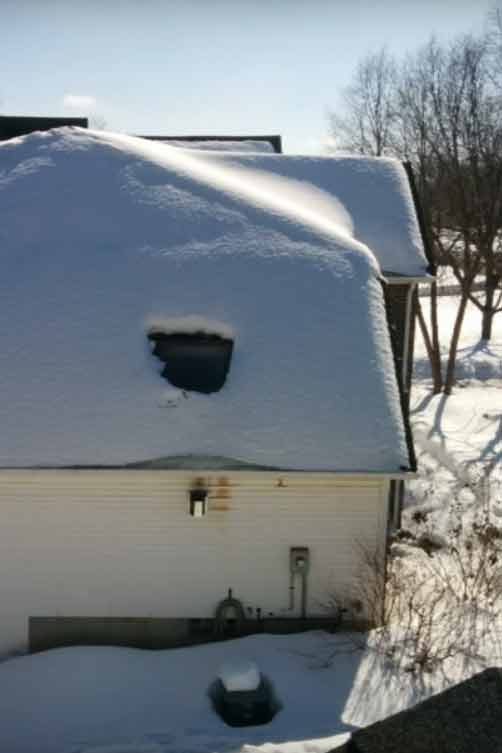Are you wondering, Why do ice dams form? There isn’t just one easy simple answer to why do ice dams form. Ice dams form for several reasons such as night time and daytime temperatures, snow depth, insulation, ventilation, inside building temperatures and these are just a few reasons why ice dams form. To get more technical we need to examine why do ice dams form in certain situations. One common situation is ice dams below skylights as discussed here.
If you have an ice dam removal emergency call IDSAFE # 612-460-0474.
Why Do Ice Dams Form
The first situation that we will discuss is a house that is properly insulated and properly ventilated and has never experienced ice dams before, but this year is different. The snow depth on the roof is so heavy and great that it suffocated the exhaust vents which allow heat to escape the roof. Since the roof was blanked with this heavy wet snow the heat was trapped in the roof which created a melting process over the entire roof surface. If the temperatures outside are cold the melting water runs down the roof and freezes on the colder overhangs which are not directly above the interior space. This constant melting and freezing will create an ice dam and eventually the water will have no where to go but in the building.
The second situation that we will cover about why do ice dams form, is a home with improper insulation. A home without proper insulation cannot contain the heat in the living spaces and instead allows the heat to radiate into the attic and therefore, the back of the roof deck also becomes warm which melts the snow. The snow melt runs down the roof and freezes on the colder eves and over hangs and gutters. Controlling the amount of heat loss with insulation is a key factor in preventing ice dams. Always insulate to code or above. Codes change all the time so it is important to keep up on the latest codes.
The third situation we will cover about why do ice dams form is a home with improper ventilation. Improper ventilation is a huge factor in ice dam formation. Occasionally when a building gets re-roofed the roofer opts to put in less heat vents or a different style of heat vent and thus reduces the amount of heat that can be released quickly out of the attic space. Any heat that enters the attic space must be allowed to escape quickly. If the heat cannot escape quickly from this space it will create a melting process and thus why ice dams form. Since ventilation is so important to ice dam formation we will discuss a few of the different styles of vents. A very common roof vent is a square metal vent about 12 inches by 12 inches and about 4-6 inches high. Normally there are several of these vents along the top roof edge near the ridge cap. These vents are very easily smothered by a large snow fall and therefore can’t always work properly. Many times roofers choose to eliminate these vents and put in a ridge vent at the very peak of the roof. From an ice dam stand point, ridge vents are very easily suffocated with a heavy deep snow fall and thus rendering them less effective. In certain applications such as rooms in attics, ridge vents are by far the best of all vents however. The third and possibly best vent ever designed is unfortunately the most unsightly and thus the least common. Many people call these turbines or whirly birds and they sit atop a large diameter pipe and usually extend above the height of the ridge or peak. These vents are very difficult to suffocate because they stick up high above the roof. These vents are designed to continually move the air around. It is very important to learn about your roof vents and remember their location and always uncover them after a large snow fall. Do not let your roof be one huge blanket of snow! Even the best houses in the world that have all the proper ventilation and insulation can still get ice dams if the vents cannot work properly.
Why Do Ice Dams Form
Why do ice dams form? All ice dams have one thing in common; they form because of too much snow on the roof. It is very important to remove snow from your roof when it becomes too deep. If you eliminate the snow from the roof it is impossible for ice dams to form. We hope this helps you understand a few of the reasons why ice dams form. By learning how do ice dams form you can prevent them. In the event that you were unable to prevent ice dams, please look for our association members and do not hesitate to call them for you ice dam steaming needs. If you have questions or need help locating our members please contact us. We reply quickly.

